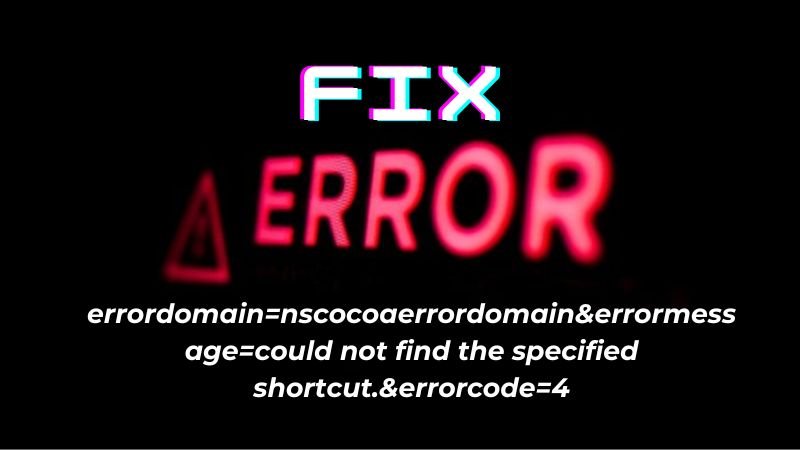Introduction: ‘errordomain=nscocoaerrordomain&errormessage=could not find the specified shortcut.&errorcode=4’ Errors”
Contents
- 1 Introduction: ‘errordomain=nscocoaerrordomain&errormessage=could not find the specified shortcut.&errorcode=4’ Errors”
- 2 Interpreting the Error Notation:
- 3 Getting to Know Error Code 4:
- 4 NSCocoaErrorDomain: What is it?
- 5 NSCocoaErrorDomain Errors Frequently Occur in the Development of Mac Operating Systems:
- 6 Possible Causes of the Error:
- 7 “errordomain=nscocoaerrordomain&errormessage=could not find the specified shortcut.&errorcode=4” troubleshooting steps:
- 8 Confirm the Resource or Shortcut’s Availability and Existence:
- 9 Verify Complete Installation and Configuration of Applicable apps:
- 10 Verify the Accuracy of Related Files and Rights:
- 11 Test Shortcuts Often:
- 12 Handle failures Carefully:
- 13 Keep App Updated:
- 14 Examine Code Frequently:
- 15 Observe Apple’s Guidelines:
- 16 Customize Error Messages:
- 17 Close Out Error Resolution:
- 18 Examine Further Sources:
- 19 Provide Feedback and recommendations:
- 20 Always Enhance Error Handling:
- 21 Put User Education Initiatives into Practice:
- 22 Create Monitoring and Alarm Systems:
- 23 Encourage communication with Apple Developers:
- 24 Conclusion
- 25 FAQ’S
- 25.1 ‘errordomain=nscocoaerrordomain&errormessage=could not find the specified shortcut.&errorcode=4’ is an error message. What does it mean?
- 25.2 What percentage of macOS and iOS app development projects contain NSCocoaErrorDomain errors?
- 25.3 ‘errordomain=nscocoaerrordomain&errormessage=could not locate the provided shortcut.&errorcode=4’ appears sometimes. What are some possible causes?
- 25.4 What actions can I take to successfully troubleshoot and resolve NSCocoaErrorDomain errors?
- 25.5 Is it possible to modify the error messages for NSCocoaErrorDomain problems to better fit the requirements of my application?
Errors may be annoying, particularly when they prevent our equipment from operating smoothly. ‘errordomain=nscocoaerrordomain&errormessage=could not find the specified shortcut.&errorcode=4’ is one such error that users of iOS and macOS frequently face. With this tutorial, we want to solve all the puzzles related to this problem and offer users all the tools they need to deal with it successfully. This article is your road map to resolving NSCocoaErrorDomain issues and restoring smooth device functioning, from interpreting the error message to investigating possible causes and troubleshooting techniques.
Interpreting the Error Notation:
To provide consumers with a thorough grasp of the error message’s significance, this section explores each of its parts. Users are better able to understand the nuances of the issue and its ramifications when each component, such as “errordomain=nscocoaerrordomain” and “errormessage=could not find the specified shortcut,” is broken down.
Getting to Know Error Code 4:
This section explains the meaning of error code 4 in the context of the error message, focusing on the NSCocoaErrorDomain. Error code 4 generally indicates that an attempt was made to locate a resource that was requested or to carry out a specified activity; this code provides users with information about the root cause of the error.
NSCocoaErrorDomain: What is it?
This article introduces users to the Cocoa framework’s NSCocoaErrorDomain, which is useful for developing iOS and macOS applications. Through an explanation of how it covers failures in file I/O, system-level operations, and data serialization, users are provided with a basic grasp of the significance of NSCocoaErrorDomain in error handling.

NSCocoaErrorDomain Errors Frequently Occur in the Development of Mac Operating Systems:
The frequency of NSCocoaErrorDomain issues during the development of macOS and iOS apps is explained in this section. Users can have a better understanding of the settings in which these mistakes frequently occur by emphasizing how frequently they occur in file-related, data-related, or networking operations.
Possible Causes of the Error:
This section offers readers insights into the reasons for the mistake by examining numerous aspects that may have contributed to its development. Depending on their unique situation, users can determine the causes of the error, ranging from failed installs and damaged files to hardware malfunctions and permission problems.
“errordomain=nscocoaerrordomain&errormessage=could not find the specified shortcut.&errorcode=4” troubleshooting steps:
This section provides a methodical approach to issue resolution by outlining specific troubleshooting procedures. Through the provision of guidance on tasks such as confirming the shortcut’s existence, examining file integrity, and guaranteeing compatibility, users may proficiently handle errors and reinstate device operation.
Confirm the Resource or Shortcut’s Availability and Existence:
This section walks users through the procedure, stressing the significance of verifying the existence and accessibility of the shortcut or resource causing the problem. By offering ways to confirm accessibility and existence—such as examining file directories and permissions—users may more precisely identify the error’s origin.
Verify Complete Installation and Configuration of Applicable apps:
This section urges users to verify the installation and configuration of pertinent apps, emphasizing their importance. Through careful attention to detail, users may minimize mistakes that may arise from improper installation or configuration.
Verify the Accuracy of Related Files and Rights:
This section emphasizes the significance of confirming file integrity and permissions, as well as how they affect the error message. Users can guarantee smoother device functioning and solve underlying issues leading to errors by fixing damaged files or inappropriate permissions.
Test Shortcuts Often:
This section stresses the need to guarantee functioning across various devices and urges users to test shortcuts extensively before launching their program. Through thorough testing, users may find and fix any shortcut problems, improving the user experience as a whole.
Handle failures Carefully:
This section emphasizes the need to give users meaningful error messages and advises them to handle NSCocoaErrorDomain-related failures carefully. Errors may be graciously handled by users and appropriate assistance can help reduce user annoyance and encourage good interactions with the app.
Keep App Updated:
This section stresses the need to keep the app up to date and gives users advice on how to remain up to date on Apple’s newest software and tool releases. Users can enhance app speed by applying updates, which provide bug fixes and improvements that may resolve NSCocoaErrorDomain problems.
Examine Code Frequently:
This section encourages developers to collaborate and examine their code frequently. To guarantee the dependability and stability of their application, users can collaborate with others to detect and resolve such problems, hence decreasing the probability of NSCocoaErrorDomain failures.

Observe Apple’s Guidelines:
This section emphasizes that users should create shortcuts in programs according to Apple’s requirements, as well as best practices. Users can lower the chance of mistakes by guaranteeing compatibility and compliance with platform standards by following Apple’s instructions.
Customize Error Messages:
This section explores the idea of modifying error messages to give users more understandable information when dealing with NSCocoaErrorDomain problems. Users may aid issue solving and increase user comprehension by personalizing error messages, which will increase user happiness.
Close Out Error Resolution:
This part wraps up the error resolution procedure by outlining the primary actions done to fix NSCocoaErrorDomain problems. Users may verify that all essential steps have been completed to successfully repair the problem and restore app functionality by concluding the error resolution process.
Examine Further Sources:
This section encourages users to look out for online forums, documentation, and support networks as additional options for extra help. By having access to more resources, users may gain from the knowledge and ideas of others, improving their troubleshooting and error-solving skills.
Provide Feedback and recommendations:
This part highlights the value of user involvement by asking users to provide feedback and recommendations for enhancing the app and the issue resolution procedure. Users may find areas for improvement and make adjustments to improve the overall user experience by requesting feedback.
Always Enhance Error Handling:
This section counsels users to always enhance error-handling procedures to promote a proactive approach to problem management. Users can limit the occurrence of NSCocoaErrorDomain issues in the future by refining error resolution algorithms and putting feedback into practice.
Put User Education Initiatives into Practice:
To improve user comprehension of error messages and troubleshooting procedures, this section recommends putting user education programs into practice. Through the provision of lessons, guidelines, or FAQs, users can enhance their ability to self-resolve issues and minimize the necessity for outside assistance.
Create Monitoring and Alarm Systems:
Users are advised to create monitoring and alarm systems to proactively detect and resolve possible issues before they hurt the functionality of their apps. Through the use of monitoring tools and warnings for anomalous activity, users may identify problems early and act quickly to fix them.
Encourage communication with Apple Developers:
To obtain knowledge and help in fixing NSCocoaErrorDomain problems, foster communication with Apple developers and support communities. By participating in the developer community, users may have access to tools and collective expertise to address complex error scenarios effectively.

Conclusion
‘errordomain=nscocoaerrordomain&errormessage=could not find the specified shortcut.&errorcode=4’ issues may appear difficult at first, but users may approach them with confidence if they have the information and techniques described in this article. Through comprehension of the error message’s constituent parts, investigation of plausible reasons, and application of methodical troubleshooting techniques, users may proficiently address NSCocoaErrorDomain issues and guarantee seamless device operation. Recall that while mistakes are unavoidable, they may be avoided and corrected for a more pleasurable and stress-free user experience.
FAQ’S
‘errordomain=nscocoaerrordomain&errormessage=could not find the specified shortcut.&errorcode=4’ is an error message. What does it mean?
The error number 4 within the NSCocoaErrorDomain is caused by the system’s inability to locate a certain shortcut, as indicated by this error message.
What percentage of macOS and iOS app development projects contain NSCocoaErrorDomain errors?
In macOS and iOS app development, NSCocoaErrorDomain failures can happen rather regularly, especially when working with files, system processes, and data management.
‘errordomain=nscocoaerrordomain&errormessage=could not locate the provided shortcut.&errorcode=4’ appears sometimes. What are some possible causes?
Answer: Incomplete installs, damaged data, permission problems, missing necessary files or resources, hardware failures, malware or virus assaults, and incorrect shortcut configurations are a few possible causes of this error.
What actions can I take to successfully troubleshoot and resolve NSCocoaErrorDomain errors?
Answer: There are a few different ways to effectively troubleshoot and resolve NSCocoaErrorDomain errors: make sure the resource or shortcut is installed and configured correctly; check that files are intact; check permissions; confirm that the system is compatible; reinstall the application; perform system restores; fix registry errors; update the operating system; install antivirus software; configure new settings; create backups; and, if necessary, seek professional assistance.
Is it possible to modify the error messages for NSCocoaErrorDomain problems to better fit the requirements of my application?
Yes, you may alter the error messages for NSCocoaErrorDomain problems to better serve the needs of your application and provide users with more information. You may improve user experience by customizing error messages according to fault codes and descriptions.



